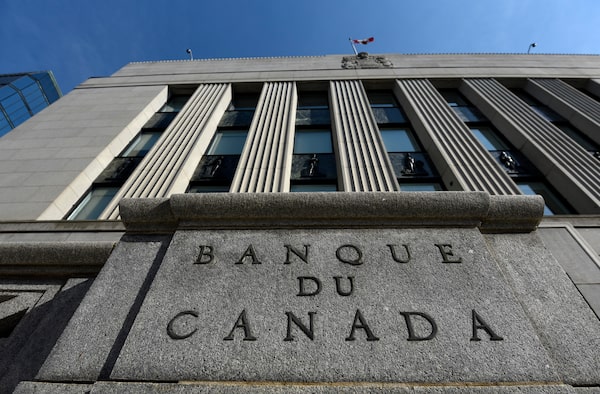
The Bank of Canada building on Wellington Street in Ottawa on May 31.Justin Tang/The Canadian Press
Forty years ago – or about the last time we had inflation rates as high as they are today – central bankers had an unhappy divorce with money supply. It had proven too volatile and unpredictable to be a reliable partner in setting monetary policy, they concluded.
Gerald Bouey, the governor of the Bank of Canada at the time, famously lamented: “We did not abandon M1, M1 abandoned us,” referring to the primary measure of money supply.
But now, some economists and central bank critics think it might be time for at least somewhat of a reconciliation.
A research paper by University of Quebec at Montreal professor Steve Ambler and C.D. Howe Institute associate director of research Jeremy Kronick, published by the institute this week, found evidence that there is still a relationship between the long-term trend in money supply growth and inflation. Further, that relationship has been intact throughout the past three decades, during which the Bank of Canada has pursued a 2-per-cent inflation target as its guiding policy objective – largely ignoring monetary aggregates such as M1 and the broader M2 in that pursuit.
“Getting money growth rates under control is critical to stabilizing inflation,” the paper concluded.
Mr. Ambler and Mr. Kronick are far from alone in taking a closer look at money supply. The current global inflation situation has raised plenty of hard questions about central banks’ beliefs and assumptions around the mechanics of inflation.
For some, especially those who question the competence and even the motives of central banks, monetarist inflation arguments provide a smoking gun. Central banks created a massive spike in money supply through quantitative easing (and governments put it into circulation through pandemic emergency supports); a massive spike in inflation ensued, after a lag; therefore, central banks created this monster, by ignoring everything economist Milton Friedman taught us about money. (“Inflation is always and everywhere a monetary phenomenon in the sense that it is and can be produced only by a more rapid increase in the quantity of money than in output.”)
Mervyn King, who was governor of the Bank of England from 2003 to 2013, wrote recently that the world’s central bankers had come to view their inflation targets as pillars of virtue in themselves – that as long as they could keep consumers’ inflation expectations around in the target, inflation would always trend back to that target. In doing so, he said, central bankers have neglected the economic mechanisms involved.
“The old idea that inflation reflects ‘too much money chasing too few goods’ is more plausible than the view that it is driven solely by expectations,” he wrote in an opinion piece published by Bloomberg. “The fact remains that we experienced a substantial, albeit transitory, increase in the growth rate of broad money, and we are now experiencing a noticeable, albeit perhaps transitory, rise in inflation.”
But even Mr. Friedman himself acknowledged that money supply made for a lousy target for central bankers to control inflation. The experience of the 1970s and early 1980s established that it just didn’t work to effectively get a read on shifting inflation pressures over the near term, nor did targeting a level of money supply have nearly the desired effect on output and prices.
Inflation targeting, on the other hand, worked marvellously well for a long time. Until it didn’t.
Mr. Ambler and Mr. Kronick said that as long as the public’s inflation expectations remain firmly anchored around a central-bank target, there doesn’t seem to be an awful lot of correlation between shorter-term movements in money supply and subsequent inflation rates. But when those expectations become unanchored from that target, the relationship between inflation and money supply re-emerges.
The Bank of Canada has been arguing that that hasn’t happened yet. But its own surveys of businesses and consumers suggest otherwise, at least over the usual two-year horizon on which the bank bases its interest-rate policy.
The bank’s quarterly Canadian Survey of Consumer Expectations, published on Monday, showed that Canadians expect inflation to still be at about 5 per cent two years from now – up sharply from 3 per cent in the third quarter of 2021. The bank’s monthly Business Leaders’ Pulse online survey, also released Monday, pegged inflation at 3.4 per cent two years from now. While both consumers and businesses still generally believe that the Bank of Canada can eventually wrestle inflation back near its target, the surveys showed cracks in that confidence.
Mr. Ambler and Mr. Kronick argue that as long as we’re in this period of what they call “unsettled” inflation, money supply will serve as a critical catalyst in reining in prices, and a valuable indicator of the inflation outlook. They said the central bank’s shift to reducing its holdings of government bonds – so-called “quantitative tightening” – is an important step to easing money-supply growth, but they cautioned that it will take as much as two years before this will translate to a reversal in the associated inflation trend.
“Money should be reintegrated by the Bank of Canada into its forecasting and monetary policy processes,” they wrote. “More timely measures of these aggregates would be a good start.”
Your time is valuable. Have the Top Business Headlines newsletter conveniently delivered to your inbox in the morning or evening. Sign up today.